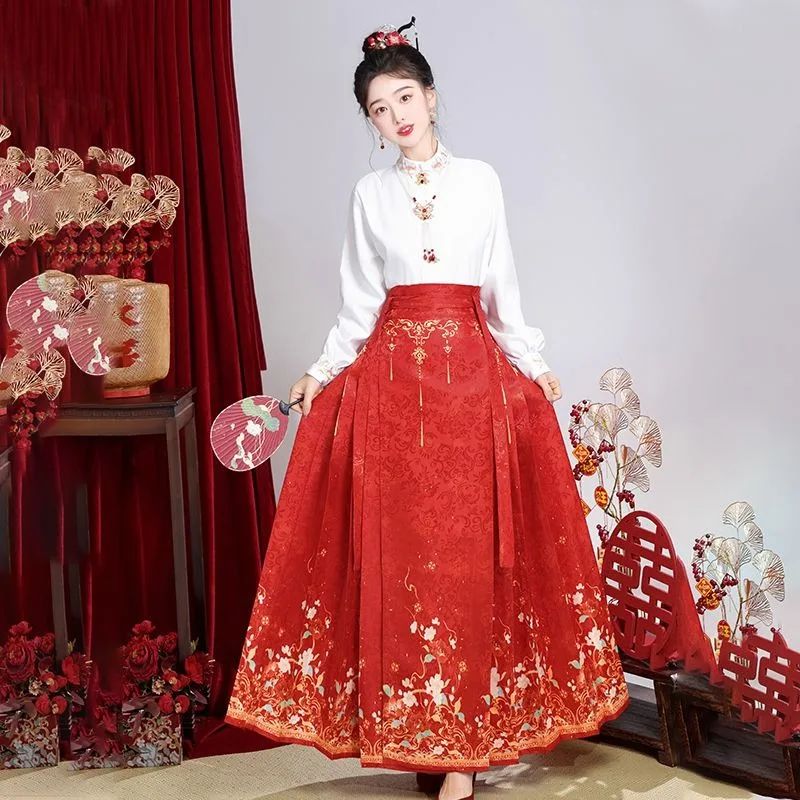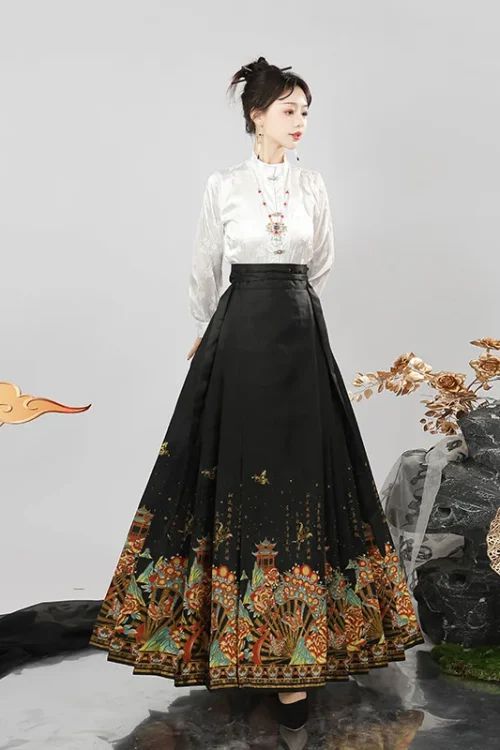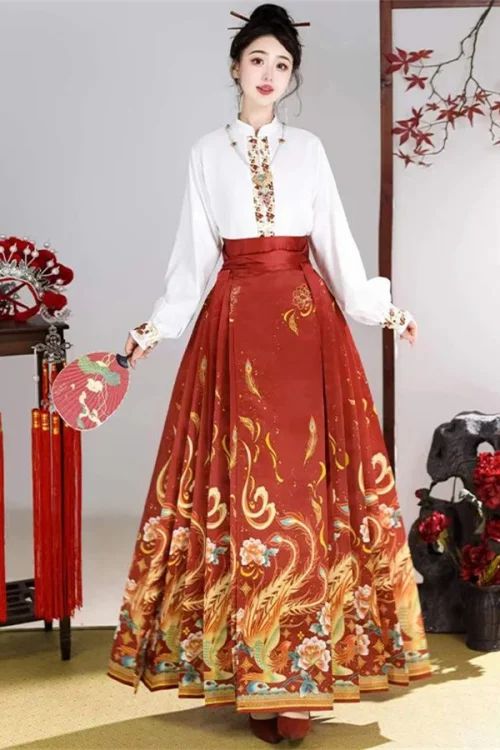The History and Significance of Mamianqun in Hanfu Mode
Mamianqun, an iconic garment in Hanfu fashion, has played a pivotal role in its revival. This traditional Rock, characterized by its pleated fabric and intricate embroidery, has captivated the hearts of fashion enthusiasts and cultural preservationists alike.

Historical Background
The history of mamianqun dates back to the Han dynasty (206 BCE – 220 CE), where it was worn by women of all social classes. Its popularity waned during subsequent dynasties, but it experienced a resurgence in the Tang dynasty (618 – 907 CE). During this period, mamianqun became a symbol of elegance and sophistication, adorned with elaborate patterns and vibrant colors.
20th Century Decline and Revival
In the 20th century, Hanfu fashion faced a decline due to Westernization and political turmoil. However, in recent years, there has been a growing interest in reviving traditional Chinese clothing. Mamianqun has emerged as a key element in this revival, capturing the essence of Hanfu’s beauty and cultural significance.
Factors Driving the Revival
The revival of mamianqun has been driven by several factors:
- Cultural Connection: It represents a connection to China’s rich cultural heritage. By wearing mamianqun, individuals can express their pride in their cultural identity and appreciate the artistry of their ancestors.
- Cultural Diversity: Mamianqun has become a symbol of cultural diversity. Its unique design and craftsmanship set it apart from Western fashion trends, showcasing the richness and variety of Chinese culture.
- Fashion Statement: Mamianqun has gained popularity as a fashion statement. Its elegant and versatile design appeals to a wide range of individuals, from traditionalists to fashion-forward trendsetters.
Challenges of Revival
The revival of mamianqun has not been without its challenges. Some critics argue that it is impractical for everyday wear, while others question its authenticity in modern society. However, these concerns have not dampened the enthusiasm of those who appreciate its beauty and cultural significance.
Fazit
In conclusion, mamianqun has played a crucial role in the revival of Hanfu fashion trends. Its historical significance, cultural symbolism, and aesthetic appeal have made it a beloved garment among those who seek to connect with their heritage and embrace the beauty of traditional Chinese clothing. As the revival of Hanfu continues, mamianqun is poised to remain a central element, inspiring future generations to appreciate the richness and diversity of Chinese culture.
The Revival of Hanfu Fashion: The Role of Mamianqun and Its Role in the Revival of Hanfu Fashion Trends
Einführung
The resurgence of Hanfu, the traditional clothing of the Han Chinese, has gained significant momentum in recent years. Among the various styles of Hanfu, mamianqun and Its Role in the Revival of Hanfu Fashion Trends, a type of skirt worn by women during the Ming-Dynastie, has played a pivotal role in this revival.

Characteristics of Mǎmiànqún
Mamianqun, literally meaning “horse-face skirt,” is characterized by its distinctive shape. It features a wide, pleated waistband that flares out into a full, A-line skirt. The waistband is often adorned with intricate embroidery or decorative patterns, while the skirt is typically made from lightweight fabrics such as silk or cotton.
Versatility and Adaptability
The popularity of mamainqun can be attributed to its versatility and adaptability. It can be dressed up or down, making it suitable for a wide range of occasions. Moreover, its loose and flowing design provides comfort and freedom of movement.
Kulturelle Bedeutung
The revival of Hanfu fashion has been driven by a growing interest in Chinese culture and heritage. Mamianqun, as a symbol of traditional Chinese aesthetics, has resonated with many young people who seek to connect with their cultural roots.
Social Media Influence
Social media platforms have played a significant role in promoting mamianqun and other Hanfu styles. Online communities and influencers have shared images and videos of themselves wearing Hanfu, inspiring others to embrace this fashion trend.
Accessibility of Hanfu
Furthermore, the availability of affordable and high-quality Hanfu garments has made it more accessible to a wider audience. Online retailers and independent designers have catered to the growing demand for Hanfu, offering a diverse range of styles and designs.
Fazit
The revival of Hanfu fashion, with mamianqun as a key player, has not only fostered a sense of cultural pride but has also contributed to the preservation and appreciation of Chinese heritage. It has sparked a renewed interest in traditional Chinese textiles, embroidery techniques, and cultural customs. As the Hanfu movement continues to gain momentum, mamianqun is expected to remain a prominent and influential style.
Styling Mamianqun: Modern Interpretations of a Traditional Kleidungsstück
Einführung
Mamianqun, a traditional Chinese garment, has experienced a resurgence in popularity as part of the revival of Hanfu fashion trends. This elegant and versatile garment, characterized by its pleated Rock and fitted bodice, has captured the attention of fashion enthusiasts and cultural preservationists alike.

Historical Origins
The origins of mamaiqnun can be traced back to the Han dynasty (206 BCE – 220 CE), where it was worn by Frauen of all social classes. The garment’s name, which translates to “horse-face skirt,” is derived from its resemblance to the shape of a horse’s face. Over the centuries, mamainqun has undergone various transformations, reflecting the evolving aesthetics and cultural influences of different eras.
Modernes Revival
In recent years, there has been a growing interest in reviving traditional Chinese fashion, including mamianqun. This revival has been driven by a desire to reconnect with cultural heritage and promote cultural diversity. Modern interpretations of mamaiqnun have emerged, blending traditional elements with contemporary design sensibilities.
Contemporary Features
Contemporary mamianqun often feature updated fabrics, such as silk blends and lightweight cottons, to enhance comfort and breathability. The traditional pleated skirt remains a defining characteristic, but designers have experimented with different pleating techniques and skirt lengths to create a range of styles. The fitted bodice has also been modernized, with variations in neckline, sleeve length, and embellishments.
Versatility in Styling
The versatility of mamianqun allows it to be styled in various ways. It can be paired with traditional accessories, such as hairpins and fans, for a more authentic look. Alternatively, it can be accessorized with modern jewelry and footwear for a more contemporary aesthetic.
Kulturelle Auswirkungen
The revival of mamianqun has not only sparked a renewed appreciation for traditional Chinese fashion but has also contributed to the growing global interest in cultural diversity. By embracing the beauty and elegance of mamianqun, we not only celebrate our cultural heritage but also promote inclusivity and cultural exchange.
